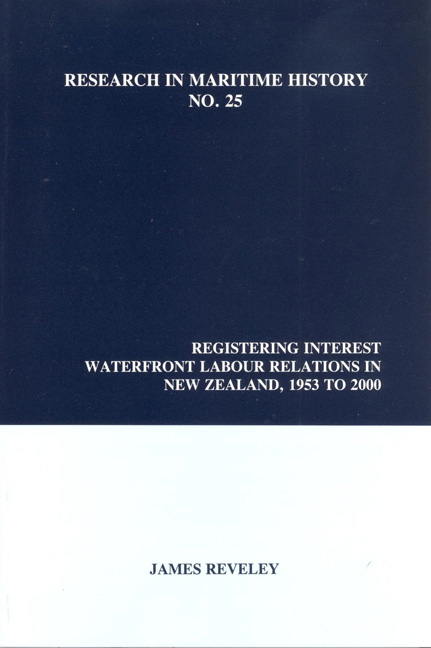Book contents
- Frontmatter
- Contents
- About the Author
- List of Figures
- List of Tables
- Acknowledgments
- Introduction
- Chapter 1 Unions and the Bureau System
- Chapter 2 The Waterfront Employers: Companies and Coordination Mechanisms
- Chapter 3 Labour Relations in the Conventional Cargo Era
- Chapter 4 Negotiating Technological Change
- Chapter 5 Labour Relations after Containerisation
- Chapter 6 Waterfront Labour Reform
- Conclusion
Chapter 2 - The Waterfront Employers: Companies and Coordination Mechanisms
- Frontmatter
- Contents
- About the Author
- List of Figures
- List of Tables
- Acknowledgments
- Introduction
- Chapter 1 Unions and the Bureau System
- Chapter 2 The Waterfront Employers: Companies and Coordination Mechanisms
- Chapter 3 Labour Relations in the Conventional Cargo Era
- Chapter 4 Negotiating Technological Change
- Chapter 5 Labour Relations after Containerisation
- Chapter 6 Waterfront Labour Reform
- Conclusion
Summary
An employers association like the New Zealand Port Employers Association (PEA) is fundamentally a coordination mechanism used to regulate wage fixing and to bolster employers’ prerogatives. If the coordination of the behaviour of firms qua employers is to be successful, organisational unity in the pursuit of common goals is necessary. In the literature on employer associations, one view is that they find it easier than labour bodies to achieve unity because the interests of the former are clearer and defined more objectively than the interests of the latter. Yet there are numerous bases for division among employers, including industry structure, level of competition and firm size, which may impede attempts at collective organisation. Recent historically-informed studies of labour relations at Australian and American ports have demonstrated that on the waterfront “capital's own organizational capacities, like labor's, are far from absolute.” New Zealand is no exception to this pattern. A key task of this chapter is to identify the fault lines within the PEA and the coordination problems that resulted. These problems foreshadowed a deepening and more complex set of divisions, addressed in chapter five, that developed in the employers’ camp following containerisation.
This chapter begins by identifying the main types of organisations involved in stevedoring that acted as “employers” by hiring waterside workers from the WIC's labour bureaus. The following section reviews the forms and functions of port administration, identifying the role that firms - as opposed to public agencies - played in service provision at New Zealand ports. The structure and composition of the PEA is then addressed. The chapter ends by documenting the shift away from shipping companies as the main employers of watersiders. As harbour boards and independent stevedoring companies became the major players within stevedoring, they assumed importance both as key actors and as a further source of fragmentation in the labour relations activities of the employers.
Ports and Port Administration
New Zealand's dependence on the export of agricultural products has meant that ports have been central to economic development. By 1867 New Zealand had approximately 112 ports, which developed largely in response to the difficulties of internal land transport associated with the country's terrain. After the First World War there was a steady decline in the number of commercial ports. By 1935 there were fifty ports, but thirteen of these handled ninety-three percent of the total tonnage of exports.
- Type
- Chapter
- Information
- Registering InterestWaterfront Labour Relations In New Zealand, 1953 To 2000, pp. 35 - 54Publisher: Liverpool University PressPrint publication year: 2003



